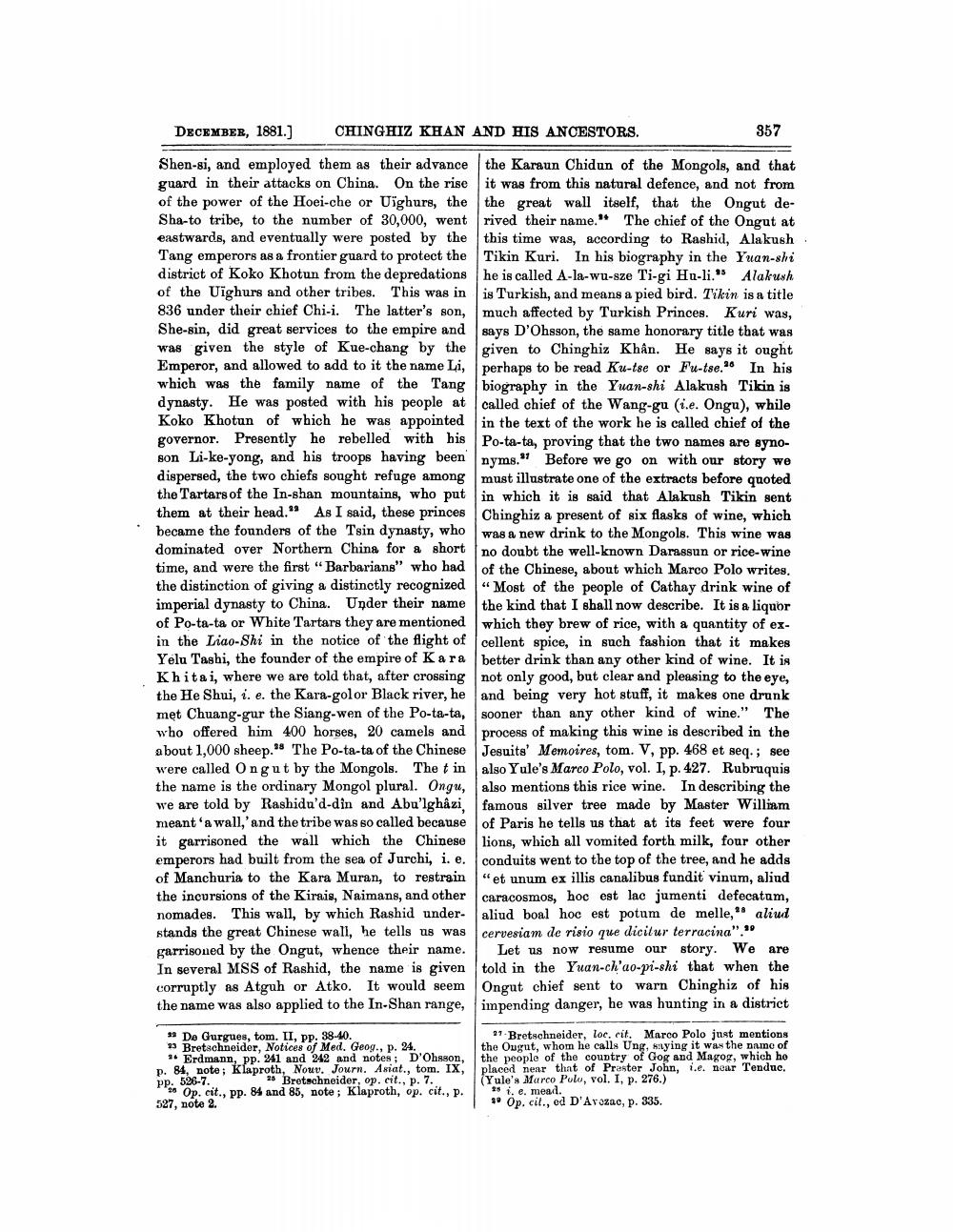________________
CHINGHIZ KHAN AND HIS ANCESTORS.
DECEMBER, 1881.]
Shen-si, and employed them as their advance guard in their attacks on China. On the rise of the power of the Hoei-che or Uighurs, the Sha-to tribe, to the number of 30,000, went eastwards, and eventually were posted by the Tang emperors as a frontier guard to protect the district of Koko Khotun from the depredations of the Uighurs and other tribes. This was in 836 under their chief Chi-i. The latter's son, She-sin, did great services to the empire and was given the style of Kue-chang by the Emperor, and allowed to add to it the name Li, which was the family name of the Tang dynasty. He was posted with his people at Koko Khotun of which he was appointed governor. Presently he rebelled with his son Li-ke-yong, and his troops having been dispersed, the two chiefs sought refuge among the Tartars of the In-shan mountains, who put them at their head." As I said, these princes became the founders of the Tsin dynasty, who dominated over Northern China for a short time, and were the first "Barbarians" who had the distinction of giving a distinctly recognized imperial dynasty to China. Under their name of Po-ta-ta or White Tartars they are mentioned in the Liao-Shi in the notice of the flight of Yelu Tashi, the founder of the empire of Kara Khitai, where we are told that, after crossing the He Shui, i. e. the Kara-golor Black river, he met Chuang-gur the Siang-wen of the Po-ta-ta, who offered him 400 horses, 20 camels and about 1,000 sheep." The Po-ta-ta of the Chinese were called Ongut by the Mongols. The tin the name is the ordinary Mongol plural. Ongu, we are told by Rashidu'd-din and Abu'lghâzi, meant 'a wall,' and the tribe was so called because it garrisoned the wall which the Chinese emperors had built from the sea of Jurchi, i. e. of Manchuria to the Kara Muran, to restrain the incursions of the Kirais, Naimans, and other nomades. This wall, by which Rashid understands the great Chinese wall, he tells us was garrisoned by the Ongut, whence their name. In several MSS of Rashid, the name is given corruptly as Atguh or Atko. It would seem the name was also applied to the In-Shan range,
22 De Gurgues, tom. II, pp. 38-40.
23 Bretschneider, Notices of Med. Geog., p. 24.
Erdmann, pp. 241 and 242 and notes; D'Ohsson, p. 84, note; Klaproth, Nouv. Journ. Asiat., tom. IX, pp. 526-7. 25 Bretschneider, op. cit., p. 7. 28 Op. cit., pp. 84 and 85, note; Klaproth, op. cit., p. 527, note 2.
357
27
the Karaun Chidun of the Mongols, and that it was from this natural defence, and not from the great wall itself, that the Ongut derived their name." The chief of the Ongut at this time was, according to Rashid, Alakush Tikin Kuri. In his biography in the Yuan-shi he is called A-la-wu-sze Ti-gi Hu-li." Alakush is Turkish, and means a pied bird. Tikin is a title much affected by Turkish Princes. Kuri was, says D'Ohsson, the same honorary title that was given to Chinghiz Khân. He says it ought perhaps to be read Ku-tse or Fu-tse. In his biography in the Yuan-shi Alakush Tikin is called chief of the Wang-gu (i.e. Ongu), while in the text of the work he is called chief of the Po-ta-ta, proving that the two names are synonyms. Before we go on with our story we must illustrate one of the extracts before quoted in which it is said that Alakush Tikin sent Chinghiz a present of six flasks of wine, which was a new drink to the Mongols. This wine was no doubt the well-known Darassun or rice-wine of the Chinese, about which Marco Polo writes. "Most of the people of Cathay drink wine of the kind that I shall now describe. It is a liquor which they brew of rice, with a quantity of excellent spice, in such fashion that it makes better drink than any other kind of wine. It is not only good, but clear and pleasing to the eye, and being very hot stuff, it makes one drunk sooner than any other kind of wine." The process of making this wine is described in the Jesuits' Memoires, tom. V, pp. 468 et seq.; see also Yule's Marco Polo, vol. I, p. 427. Rubruquis also mentions this rice wine. In describing the famous silver tree made by Master William of Paris he tells us that at its feet were four lions, which all vomited forth milk, four other conduits went to the top of the tree, and he adds "et unum ex illis canalibus fundit vinum, aliud caracosmos, hoc est lac jumenti defecatum, aliud boal hoc est potum de melle, aliud cervesiam de risio que dicitur terracina".""
Let us now resume our story. We are told in the Yuan-ch'ao-pi-shi that when the Ongut chief sent to warn Chinghiz of his impending danger, he was hunting in a district
21-Bretschneider, loc. cit. Marco Polo just mentions the Ougut, whom he calls Ung, saying it was the name of the people of the country of Gog and Magog, which he placed near that of Prester John, i.e. near Tenduc. (Yule's Marco Polo, vol. I, p. 276.)
25 i, e. mead.
Op. cit., ed D'Avozac, p. 335.




